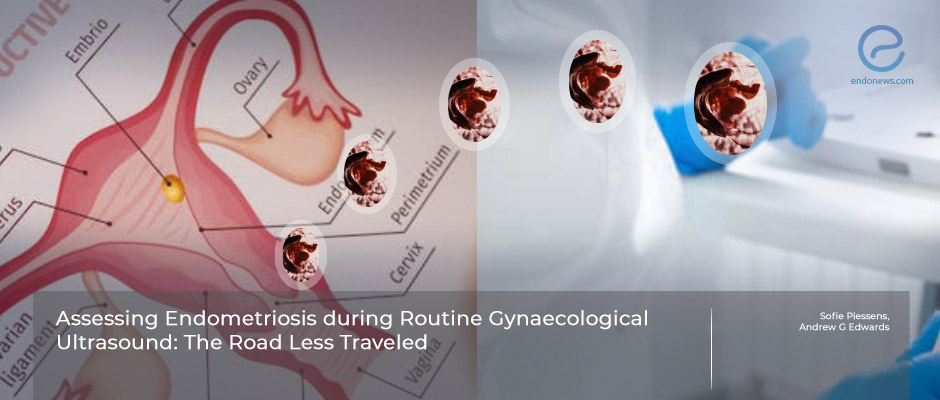A prediction model to identify endometriosis during routine ultrasound .
Oct 19, 2022
A prediction model was proposed to assess the need for ureterolysis preoperatively.
Key Points
Importance:
- It is worth evaluating the structural mobility and looking for the deep nodules during the routine transvaginal ultrasonography examinations of the uterus, ovaries, and posterior and anterior pelvic compartments.
- Better utilization of ultrasound will prevent the delay in the diagnosis of endometriosis and decline the number of patients who expose to unnecessary repeat procedures due to the need for a multidisciplinary approach.
Highlights:
- This study has shown that patients who have combinations of dyschezia, ovarian immobility, and deep endometriotic lesions in ultrasonographic evaluation require a higher rate of ureterolysis.
- It is necessary to evaluate the possibility of predicting the need for ureterolysis with the clinic and sonographic data for deeply infiltrating endometriosis cases.
What's done here:
- A retrospective observational study was conducted on 177 consecutive patients in two Australian hospitals to design modeling over a 4-year time period.
- Patients who were ultrasonographically diagnosed with deeply infiltrating endometriosis and underwent laparoscopic surgery during this time were selected.
- The demographic, clinical findings, transvaginal ultrasonography, and intraoperative data were extracted from electronic records.
- Multi-categorical decision trees and baseline models were built to choose the most correlated variables.
Key Results:
- During the study, patients were divided into 2 groups according to their surgery [cases with (51,4%) and without ureterolysis (48,6%)].
- In the ureterolysis group, ovaries were immobile in a significantly higher number of cases, retrospectively.
- Among patients with bowel endometriosis, the percentage of ureterolysis was extremely high (95,5%) and was statistically important.
Limitations and strengths:
- The statistical methods that were used to evaluate the variables were strengths of the study.
- The retrospective nature and the operations performed by a highly skilled surgeon in two tertiary centers can result in a possible selection bias.
Lay Summary
. Ureterolysis is an advanced surgical technique that involves dissection of the ureter from pelvic brim to the ureteric tunnel to avoid injury or freeing the ureter from endometriotic lesions. This manipulation usually requieres advanced surgical training and skill. In the absence of preoperative prediction sites with deeply invaded endometriosis, the improper hands not only can cause inadequate cytoreduction but also cause destruction of the ureters. Therefore, preoperative transvaginal ultrasonography that predicts deep endometriosis and possible ureterolysis is essential.
. Zanardi et al. from the University Hospital in Sydney, New South Wales, Australia designed a modelling on patients with deep endometriosis who underwent laparoscopic surgery between Jan 2017 and Feb 2021. Their aim were to develop a model, including clinical features and ultrasonographic findings to predict the need for ureterolysis during laparoscopic surgery for endometriosis.
. During the laparoscopic surgery of consequtively selected 177 patients, only 91 of them had ureterolysis and 86 did not. The depth of endometriotic lesions, the greatest diameter of left and right ovarian endometriosis, the left and right uterosacral involvements were also evaluated comparing the groups of ureterolysis and unureterolysis.
. All spesificity, sensivity, positive and negative predictive values, precision mean and accuracy mean statistically evaluated among variables.
. In the final model, the prognostic variables for ureterolysis appeared to be dyschezia, absence of ovarian mobility, presence of endometriosis in right or left uterosacral ligaments, and presence of bowel endometriosis during ultrasonographic eveluation. Among these variables, the presence of bowel DE visualized on ultrason alone raised the risk of ureterolysis 71%.
. The authors pointed out that experienced surgeon should performed the endometriosis surgery with bowel endometriosis due to highly correlation with ureterolysis. They reported high risk of ureterolysis among patients with immobile ovaries, dyschezia and DE lesions of bowel,and/or uterosacral ligaments visualized during transvaginal ultrasonography preoperatively.
. This interesting reseach were recently published in the J. of Minimally Invasive Gynecology.
Research Source: https://pubmed.ncbi.nlm.nih.gov/36007835/
prediction model ultrasonography bowel surgery ureterolysis endometriosis.

